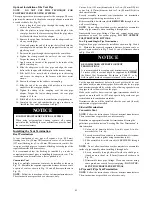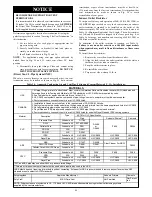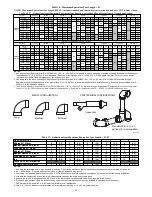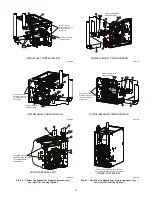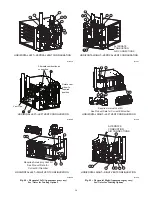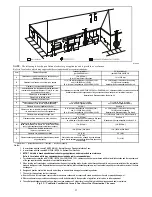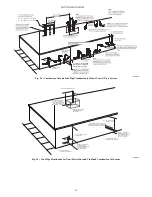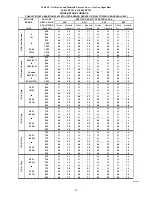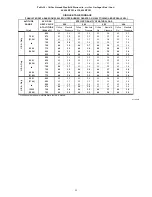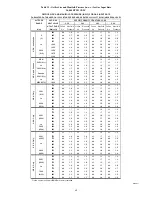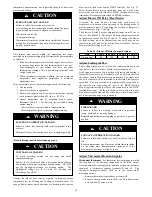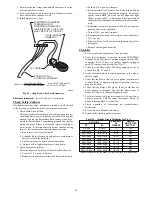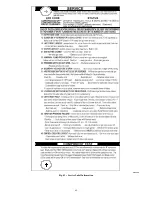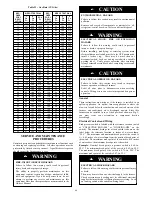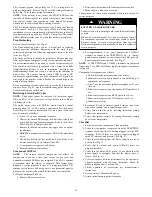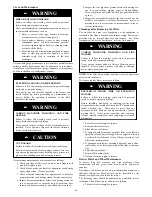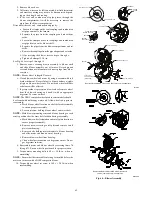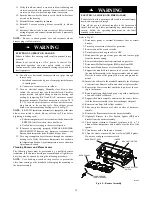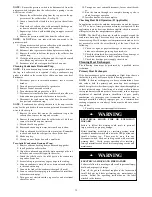
57
Adjustments
FIRE HAZARD
Failure to follow this warning could result in personal
injury, death and/or property damage.
DO NOT bottom out gas valve regulator adjusting screw.
This can result in unregulated manifold pressure and result
in excess overfire and heat exchanger failures.
!
WARNING
FURNACE DAMAGE HAZARD
Failure to follow this caution may result in reduced furnace
life.
The 26,000 BTUH model has a lower nominal manifold
pressure than other models. Do not adjust the natural gas
manifold pressure above 1.8--in. W.C.
The 26,000 BTUH model can be identified by the green
label affixed to the solenoid of the gas valve.
Refer to the Adjustment section for setting the manifold
pressure.
USE TABLE 19 WHEN ADJUSTING 26,000 BTUH
MODEL MANIFOLD PRESSURE.
CAUTION
!
FURNACE DAMAGE HAZARD
Failure to follow this caution may result in reduced furnace
life.
DO NOT redrill orifices. Improper drilling (burrs,
out--of--round holes, etc.) can cause excessive burner noise and
misdirection of burner flames. This can result in flame
impingement of heat exchangers, causing failures. See Fig.
59.
CAUTION
!
For proper operation and long term reliability, the Furnace input
rate must be /--2 percent of input rate on furnace rating
plate, or as adjusted for altitude.
The gas input rate on rating plate is for installations at altitudes up
to 2000 ft. (609.6M).
BURNER
ORIFICE
A93059
Fig. 59 -- Orifice Hole
The NATURAL GAS manifold pressure adjustments in Tables
18 and 19 compensate for BOTH altitude AND gas heating
value. DO NOT apply an additional de--rate factor to the
pressures show in Table 18 and 19. The values in this table
are NOT referenced to sea level; they are AS--MEASURED
AT ALTITUDE.
The heating content of natural gas at altitude may already
provide for a reduction in capacity of the furnace. Be sure to
obtain the expected in--season gas heating value of the gas
from the gas supplier BEFORE making any adjustments for
capacity or altitude.
Refer to Table 18 and 19.
No
adjustments to the furnace may be necessary at altitude for
certain gas heating values.
Refer to the instructions provided in the factory--specified
LP/Propane conversion kit for instructions for setting gas
manifold pressures for LP/Propane applications.
NOTICE
In the USA., the input rating for altitudes above 2000 ft. (609.6M)
must be reduced by 2 percent for each 1000 ft. (304.8M) above sea
level. Refer to Table 18 or 19 . The natural gas manifold pressures
in Table 19 adjust for BOTH altitude and natural gas heating value.
In Canada, the input rating must be reduced by 5 percent for
altitudes of 2000 ft. (609.6M) to 4500 ft. (1371.6M) above sea
level. The natural gas manifold pressures in Table 18 adjust for
BOTH altitude and natural gas heating value.
NOTE
: For Canadian altitudes of 2000 to 4500 ft. (610 to 1372
M), use USA altitudes of 2001 to 2000 ft. (611 to 914 M) in Table
18 or 19.
To adjust manifold pressure to obtain the proper input rate, first,
determine if the furnace has the correct orifice installed. At higher
altitudes or different gas heat contents, it may be necessary to
change the factory orifice to a different orifice. Tables have been
provided in the furnace installation instructions to match the
required orifice to the manifold pressure to the heat content and
specific gravity of the gas. To do this:
1. Obtain average yearly gas heat value (at installed altitude)
from local gas supplier.
2. Obtain average yearly gas specific gravity from local gas
supplier.
3. Find installation altitude in Table 18 or 19.
4. Find closest natural gas heat value and specific gravity in
Table 18 or 19. Follow heat value and specific gravity lines
to point of intersection to find orifice size and manifold
pressure settings for proper operation.
5. Check and verify burner orifice size in furnace. NEVER
ASSUME ORIFICE SIZE. ALWAYS CHECK AND
VERIFY.
If orifice hole appears damaged or it is suspected to have been
redrilled, check orifice hole with a numbered drill bit of
correct size. Never redrill an orifice. A burr--free and squarely
aligned orifice hole is essential for proper flame characteristics.
NOTICE
6. Replace orifice with correct size, if required by Table 18 or
19. Use only factory--supplied orifices. See EXAMPLE 1.
EXAMPLE
1: 0 -- 2000 ft. (0 -- 609.6M) altitude
Heating value = 1050 Btu/cu ft.
Specific gravity = 0.62
Therefore: Orifice No. 44
Manifold pressure: 3.4--in. w.c. (847 Pa)
(Furnace is shipped with No. 44 orifices. In this example, all main
burner orifices are the correct size and do not need to be changed to
obtain proper input rate.)
NOTE
: To convert gas manifold Table pressures to Pascals,
multiply the in. w.c. value by 249.1 Pa/in. w.c. (1 in. w.c. = 249.1
Pa).
Содержание 915SB
Страница 65: ...65 A190099 Fig 63 Service Label Information...
Страница 76: ...76 A190093 Fig 69 Troubleshooting Guide Cont...
Страница 77: ...77 344442 2 Rev C A190259 Fig 70 Wiring Diagram...

